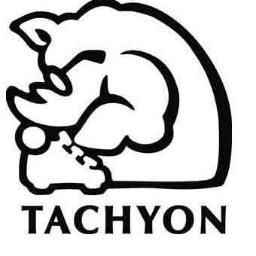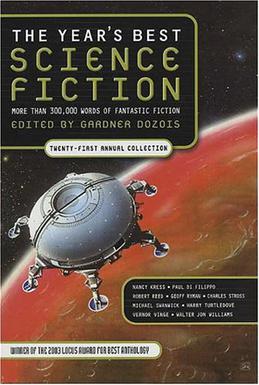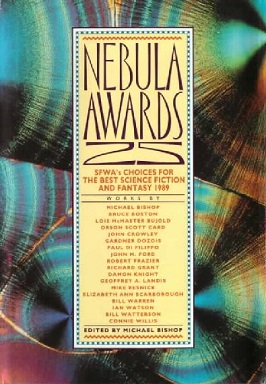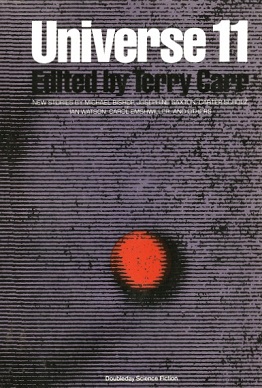Related Research Articles
Damien Francis Broderick is an Australian science fiction and popular science writer and editor of some 74 books. His science fiction novel The Dreaming Dragons (1980) introduced the trope of the generation time machine, his The Judas Mandala (1982) contains the first appearance of the term "virtual reality" in science fiction, and his 1997 popular science book The Spike was the first to investigate the technological singularity in detail.
Michael Lawson Bishop was an American author. Over five decades and in more than thirty books, he created what has been called a "body of work that stands among the most admired and influential in modern science fiction and fantasy literature."
Barry Nathaniel Malzberg is an American writer and editor, most often of science fiction and fantasy.

Nemonymous was an experimental short fiction publication that labeled itself a "megazanthus". It was published and edited in the United Kingdom from 2001–2010 by D.F. Lewis.
Biopunk is a subgenre of science fiction that focuses on biotechnology. It is derived from cyberpunk, but focuses on the implications of biotechnology rather than mechanical cyberware and information technology. Biopunk is concerned with synthetic biology. It is derived from cyberpunk and involve bio-hackers, biotech megacorporations, and oppressive government agencies that manipulate human DNA. Most often keeping with the dark atmosphere of cyberpunk, biopunk generally examines the dark side of genetic engineering and depicts the potential perils of biotechnology.

Paul Di Filippo is an American science fiction writer.

A Reverie for Mister Ray: Reflections on Life, Death, and Speculative Fiction is a collection of nonfiction work by American writer Michael Bishop published in 2005 by PS Publishing. It includes essays and reviews from 1975 to 2004, originally published in a wide variety of newspapers, magazines, literary journals, and fanzines. Most of the pieces concern the speculative fiction genre. The book was edited by Michael H. Hutchins.
Paul Cook is an American science fiction writer and classical music critic. He is a Principal Lecturer in the English Department at Arizona State University.

Tachyon Publications is an independent press specializing in science fiction and fantasy books. Founded in San Francisco in 1995 by Jacob Weisman, Tachyon books have tended toward high-end literary works, short story collections, and anthologies.

The Year's Best Science Fiction: Twenty-First Annual Collection is a science fiction anthology edited by American writer Gardner Dozois, published in 2004. It is the 21st in The Year's Best Science Fiction series. The anthology was published in the UK as The Mammoth Book of Best New Science Fiction 17.

Forbidden Planets (2006) is a science fiction anthology of all-new short stories edited by British writer and journalist Peter Crowther, the fifth in his themed science fiction anthology series for DAW Books. The stories are all intended to be inspired by the 1956 movie, Forbidden Planet. The book was published in 2006.

The Lives and Times of Jerry Cornelius is a collection of short stories by British fantasy and science fiction writer Michael Moorcock. It is part of his long-running Jerry Cornelius series. The book was originally published by Allison & Busby in 1976 and collects stories originally published between 1969 and 1974. A later edition was published in 2003 by Four Walls Eight Windows, in which four stories from the original edition are replaced.

Lou Anders is a US-based author, known for the Thrones & Bones series of middle grade fantasy novels. Anders is a Hugo Award-winning editor, a Chesley Award-winning art director, a journalist, a children's author, and a tabletop roleplaying game designer. In 2021, Anders launched Lazy Wolf Studios to publish tabletop roleplaying game material set in the world of his novels.
Abyss & Apex Magazine (A&A) is a long-running, semi-pro online speculative fiction magazine. The title of the zine comes from a quote by Friedrich Nietzsche (1844-1900), "And if you gaze long into the abyss, the abyss gazes also into you." The stories and poetry therefore follow the pattern of "how would humans react?" if a new technology or a type of magic or supernatural power affected them.
A list of the published work of Paul Di Filippo, American author.

Nebula Awards 25 is an anthology of award winning science fiction short works edited by Michael Bishop, the third of three successive volumes published under his editorship. It was first published in hardcover and trade paperback by Harcourt Brace Jovanovich in April 1991.

Nebula Awards 24 is an anthology of award-winning science fiction short works edited by Michael Bishop, the second of three successive volumes published under his editorship. It was first published in hardcover and trade paperback by Harcourt Brace Jovanovich in April 1990.

Nebula Award Stories Seventeen is an anthology of award winning science fiction short works edited by Joe Haldeman. It was first published in hardcover by Holt, Rinehart and Winston in August 1983; a paperback edition was issued by Ace Books in June 1985 under the variant title Nebula Award Stories 17.

Universe 11 is an anthology of original science fiction short stories edited by Terry Carr, the eleventh volume in the seventeen-volume Universe anthology series. It was first published in hardcover by Doubleday in June 1981, with a paperback edition from Zebra Books in January 1983.
"Danny Goes to Mars" is a science fiction short story by American writer Pamela Sargent. It was first published in Isaac Asimov's Science Fiction Magazine, in October 1992.
References
- ↑ The Quickening, at Science Fiction Writers of America; retrieved August 20, 2021
- ↑ "The fantasy fiction of Michael Bishop", by Paul Di Filippo; originally published in THE SCRIBNER WRITERS SERIES: SUPERNATURAL FICTION WRITERS (2003, edited by Richard Bleiler); archived on LiveJournal, 2007